unexpected IFR training startup
-
Members Online
- Flyler
- richardbrochu27
- Conrad
- Adam Belle
- AJ88V
- A64Pilot
- irishpilot
- Pinecone
- DCarlton
- charlesual
- Rmfriday
- Echo
- Little Dipper
- Blaze
- tankles
- buddy
- Marc B
- sdmideas
- rbmaze
- EricJ
- drpovation
- redbaron1982
- AndreiC
- lanejacobs84
- Justin Schmidt
- PeterRus
- Slick Nick
- Fly Boomer
- jma201
- cferr59
- donkaye
- amillet
- Jim F
- PMcClure
- MattD89
- bradp
- NickG
- Fredo0709
- exM20K
- kortopates
- TCC
- Rick Junkin
- BlueDun


Recommended Posts
Join the conversation
You can post now and register later. If you have an account, sign in now to post with your account.